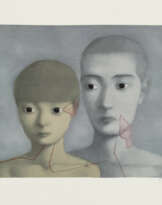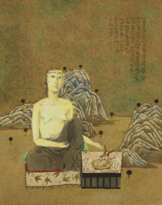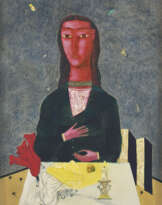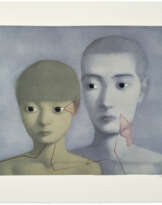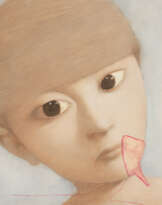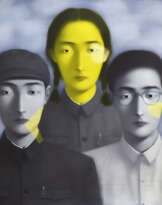ID 813886
Лот 76 | Zhang Xiaogang (né en 1958)
Оценочная стоимость
€ 500 000 – 800 000
Camarade
signé en chinois et en pinyin, daté '2000' (en bas à droite)
huile sur toile
190 x 150 cm.
Peint en 2000.
signed in Chinese and in Pinyin, dated '2000' (lower right)
oil on canvas
74 3/4 x 59 in.
Painted in 2000.
Provenance
Atelier de l'artiste, Pékin
Galerie de France, Paris
Acquis auprès de celle-ci en 2003
Exhibited
Amiens, Musée de Picardie, Passe-Murailles - Nouvelles Scènes de l'Art Contemporain Chinois, décembre 2000-mars 2001 (illustré en couleurs au catalogue d'exposition p. 48).
Paris, Galerie de France, Zhang Xiaogang, Forget and Remember, mai-juillet 2003.
Special notice
This item will be transferred to an offsite warehouse after the sale. Please refer to department for information about storage charges and collection
details.
Post lot text
« C’est un tableau qui hurle dans un silence total. Je le mettrais bien à côté d’un Munch. C’est un cri chinois quand Munch est un cri européen ». - Michèle deFlers
"It is a painting that screams in total silence. I would place it next to a Munch. It is a Chinese scream when Munch is a European scream.’’ - Michèle de Flers
« Une image a priori simple raconte, en fait, beaucoup de choses. Nous avons, par exemple, acheté une œuvre de la série Les Camarades de Zhang Xiaogang, figurant un homme au visage immobilisé, glacé, sans expression. […] Le regard vide semble dire ‘On a tellement souffert, on ne doit rien exprimer’. La tache rouge sur le front renvoie au Petit Livre rouge de Mao ». - Jean-Jacques & Michèle de Flers
“In fact, a simple image tells a lot of things. For example, we bought a work from the series Les Camarades by Zhang Xiaogang, showing a man with an immobilised, frozen, expressionless face [...] The empty gaze seems to say: “We have suffered so much, we must not express anything. The red spot on the forehead refers to Mao's Little Red Book.'' - Jean-Jacques & Michèle de Flers
« J'ai commencé à peindre des 'portraits de famille' en 1993 parce que j'étais ému par les vieilles photographies. Il m'est difficile d'expliquer quelle partie de mon âme a été touchée par ces images anciennes soigneusement polies. Elles suscitaient des souvenirs aléatoires. Je ne pouvais pas les lâcher. Au bout d'un certain temps, j'ai réalisé que, outre le contexte historique qui se cachait derrière les images, ce qui me touchait dans ces portraits standardisés était précisément la formule 'polie' qui les caractérisait. Elles incarnent une esthétique séculaire etparticulière de la culture populaire chinoise, à savoir une individualité indistincte, une beauté 'poétique' ». (Citation de Zhang dans Report from the Artist's Studio 1996 dans H. Wu(ed.), Contemporary Chinese Art Primary Documents, New York,2010,pp.190-191).
Peinte en 2000, Camarade est une œuvre issue de Bloodline, la plus célèbre série de Zhang Xiaogang, inspirée de vieilles photographies de famille. Au début du XXème siècle, la photographie était un support coûteux et une photographie de famille était d’autant plus importante pour les Chinois, car elle était très précieuse et avait une grande valeur émotionnelle. Zhang peint des portraits de famille et d'individus semblables à des photographies et les utilise pour refléter les questions sociopolitiques de l'époque, en particulier la relation entre les souvenirs personnels et les expériences collectives de la société chinoise dans son ensemble. Plus tard, Bloodline est devenue la série la plus recherchée de l'artiste et a été considérée comme marquant de manière significative cette période de l'art contemporain chinois.
Le tableau Camarade représente des éléments caractéristiques de la série : un jeune homme aux yeux monopaupières, au visage fin et aux cheveux bien peignés, portant un costume Zhongshan traditionnel. Il fixe solennellement le spectateur à travers l'appareil photo, son teint légèrement rosé et la tache lumineuse rouge caractéristique sur sa joue gauche ajoutent un peu de mystère au tableau, surtout en contraste avec le subtil fond gris.
“I began to paint 'family portraits' in 1993 because I was moved by old photographs. It is hard for me to explain which nerve of my soul was touched by these carefully polished old pictures. They stirred random recollections. I could not let go of them. After a while, I gradually realized that, besides the historical background behind the pictures, what touched me in those standardized portraits was precisely the formulaic 'polished-ness' about them. It embodies an age-old, specific aesthetic of Chinese popular culture, namely indistinctin dividuality, a 'poetic' beauty.”(Zhang quoted in Report from the Artist's Studio, 1996 in H. Wu (ed.), Contemporary Chinese Art Primary Documents, New York, 2010, pp.190-191.).
Painted in 2000, Camarade is a work hailing from Zhang Xiaogang's most renowned Bloodline series, inspired by old family photographs. In the early 20th century, photography used to be an expensive medium and a family photo was even more important to Chinese people as it was very precious and held a lot of emotional value. Zhang paints photograph-like family and individual portraits and uses them to reflect the socio-political issues of the times, in particular regarding the relation between one’s personal memories and the collective experiences of Chinese society at large. Later, Bloodline became the most sought-after series of the artist — and considered as epoch-defining for contemporary Chinese art.
The painting Camarade represents characteristics elements of the series: a young man with monolid eyes, a slender face and well-combed hair, wearing a traditional Zhongshan suit. Staring solemnly at the viewer through the camera, his slightly pinkish skin tone and the signature light red patch on his left-side cheek adds some mystery to the painting, especially in contrast with the subtle grey background.
| Автор: | Чжан Сяоган (1958) |
|---|---|
| Техника исполнения: | Масло на холсте |
| Художественный стиль: | Современное искусство |
| Место происхождения: | Китай, Восточная Азия, Азия |
| Категория аукционного дома: | Картины |
| Автор: | Чжан Сяоган (1958) |
|---|---|
| Техника исполнения: | Масло на холсте |
| Художественный стиль: | Современное искусство |
| Место происхождения: | Китай, Восточная Азия, Азия |
| Категория аукционного дома: | Картины |
| Адрес торгов |
CHRISTIE'S 9 Avenue Matignon 75008 Paris Франция | ||||||||||||||
|---|---|---|---|---|---|---|---|---|---|---|---|---|---|---|---|
| Предосмотр |
| ||||||||||||||
| Телефон | +33 (0)1 40 76 85 85 | ||||||||||||||
| Факс | +33 (0)1 40 76 85 86 | ||||||||||||||
| Условия использования | Условия использования | ||||||||||||||
| Транспортировка |
Почтовая служба Курьерская служба Самовывоз | ||||||||||||||
| Способы оплаты |
Банковский перевод | ||||||||||||||
| Часы работы | Часы работы
|




